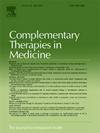Transcutaneous electrical acupoint stimulation for hypertension complicated by anxiety or sleep disorders: A pilot randomized controlled trial
IF 3.3
3区 医学
Q1 INTEGRATIVE & COMPLEMENTARY MEDICINE
引用次数: 0
Abstract
Background
Hypertension is often accompanied by anxiety and sleep disorders, which further complicate the disease. This study aimed to evaluate the feasibility and effectiveness of transcutaneous electrical acupoint stimulation (TEAS) in patients with hypertension and anxiety or sleep disorders.
Methods
Eligible participants were randomly assigned to the 10 Hz TEAS, 2 Hz TEAS, or routine treatment groups in a 1:1:1 ratio. Participants continued their routine treatment during the trial, while those in the two TEAS groups received 12 sessions of 30-min TEAS treatment with different stimulation frequencies. The feasibility parameters were successful screening probability, enrollment rate, and dropout rate. The primary outcome was the change in office systolic blood pressure from baseline to week four. Secondary outcomes included changes in office diastolic blood pressure, heart rate, Pittsburgh Sleep Quality Index score, and Generalized Anxiety Disorder 7-item scale score from baseline to week four.
Results
Eighty-eight participants (age 58.0 [51.0, 63.0] years; 49 women) were randomized. The successful screening probability was 56.1 %, the enrollment rate was 3.1 participants per week, and the dropout rate was 14.8 %. The change in office systolic blood pressure from baseline to week four was −2.8 ± 13.6 mm Hg, −6.4 ± 10.0 mm Hg, and −7.2 ± 11.2 mm Hg, respectively, in the 10 Hz TEAS, 2 Hz TEAS, and routine treatment groups (P = 0.332). No significant differences were noted, except for a change in the Pittsburgh Sleep Quality Index score (P = 0.014). Both 10 Hz (P = 0.024) and 2 Hz TEAS (P = 0.039) significantly improved sleep quality compared to routine treatment.
Conclusions
In patients with hypertension having anxiety or sleep disorders, this study did not demonstrate the superiority of TEAS over routine treatment but did show an improvement in sleep quality and a downward trend in diastolic blood pressure. Therefore, a largescale trial is warranted.
经皮穴位电刺激治疗高血压合并焦虑或睡眠障碍:一项随机对照试验。
背景:高血压常伴有焦虑和睡眠障碍,使其进一步复杂化。本研究旨在评估经皮穴位电刺激(TEAS)治疗高血压合并焦虑或睡眠障碍患者的可行性和有效性。方法:符合条件的参与者按1:1:1的比例随机分配到10Hz tea、2Hz tea或常规治疗组。在试验期间,参与者继续他们的常规治疗,而两个tea组的参与者接受了12次30分钟的不同刺激频率的tea治疗。可行性参数为筛选成功率、入学率和辍学率。主要终点是从基线到第四周办公室收缩压的变化。次要结果包括从基线到第四周办公室舒张压、心率、匹兹堡睡眠质量指数评分和广泛性焦虑障碍7项量表评分的变化。结果:88例参与者(年龄58.0[51.0,63.0]岁;49名女性)随机选取。筛查成功率为56.1%,入组率为每周3.1人,退组率为14.8%。从基线到第四周,10Hz tea组、2Hz tea组和常规治疗组的办公室收缩压变化分别为-2.8±13.6mm Hg、-6.4±10.0mm Hg和-7.2±11.2mm Hg (P=0.332)。除了匹兹堡睡眠质量指数得分的变化(P=0.014)外,没有发现显著差异。与常规治疗相比,10Hz (P=0.024)和2Hz tea (P=0.039)显著改善了睡眠质量。结论:在患有焦虑或睡眠障碍的高血压患者中,本研究并未显示tea优于常规治疗,但确实显示睡眠质量改善和舒张压下降趋势。因此,有必要进行大规模试验。
本文章由计算机程序翻译,如有差异,请以英文原文为准。
求助全文
约1分钟内获得全文
求助全文
来源期刊

Complementary therapies in medicine
医学-全科医学与补充医学
CiteScore
8.60
自引率
2.80%
发文量
101
审稿时长
112 days
期刊介绍:
Complementary Therapies in Medicine is an international, peer-reviewed journal that has considerable appeal to anyone who seeks objective and critical information on complementary therapies or who wishes to deepen their understanding of these approaches. It will be of particular interest to healthcare practitioners including family practitioners, complementary therapists, nurses, and physiotherapists; to academics including social scientists and CAM researchers; to healthcare managers; and to patients. Complementary Therapies in Medicine aims to publish valid, relevant and rigorous research and serious discussion articles with the main purpose of improving healthcare.
 求助内容:
求助内容: 应助结果提醒方式:
应助结果提醒方式:


